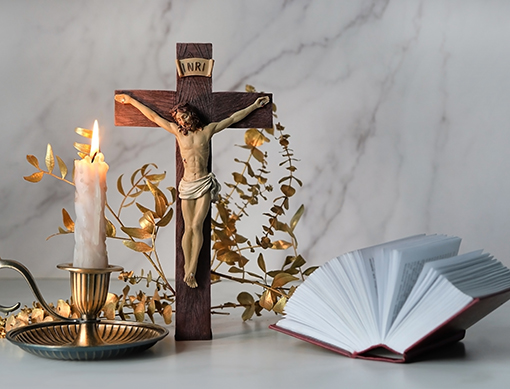Sacramentals are sacred signs that prepare us to receive the chief effects of the seven sacraments we recognize: baptism, confirmation, the Eucharist, penance, holy orders, matrimony, and anointing of the sick. Sacramentals, like sacraments, use symbols to lead us to deeper meaning. Water, palms, ashes are some examples from natural objects used for sacramentals. Others are shaped by human hands for use in personal and public prayer, such as candles, statues, rosaries, crosses, crucifixes, and scapulars.
 All created things are signs of God that we decipher in order to find our way to God. The very notion of “sacrament” depends on the idea that God can be found in this world. By the Church's prayer, sacramentals prepare us to receive grace and dispose us to cooperate with it (CCC #1670). Sacramentals are not magic talismans or amulets. They do not contain in themselves some powers. God can communicate grace through them. God can still communicate grace without us using sacramentals, of course, but sacramentals involve our senses as well as our minds. Once it is blessed, an object is set apart from the ordinary; it is holy. When a sacramental wears out or is no longer needed, it is disposed of respectfully.
All created things are signs of God that we decipher in order to find our way to God. The very notion of “sacrament” depends on the idea that God can be found in this world. By the Church's prayer, sacramentals prepare us to receive grace and dispose us to cooperate with it (CCC #1670). Sacramentals are not magic talismans or amulets. They do not contain in themselves some powers. God can communicate grace through them. God can still communicate grace without us using sacramentals, of course, but sacramentals involve our senses as well as our minds. Once it is blessed, an object is set apart from the ordinary; it is holy. When a sacramental wears out or is no longer needed, it is disposed of respectfully.
How does an ordinary object become a sacramental? The Catechism of the Catholic Church (#1668) tells us, "(Sacramentals) always include a prayer, often accompanied by a specific sign, such as the laying on of hands, the sign of the cross, or the sprinkling of holy water (which recalls Baptism).” Blessings of bishops, priests and deacons, using the proper prayers, make water and other objects into sacramentals. The holy oils used in the sacraments of Baptism and Confirmation and to anoint the sick have been blessed by a bishop.
Sacramentals in Your Classroom. Point out the sacramentals on your prayer table, walls, doors and shelves. Discuss how these objects remind us of God’s love. View “Setting the Prayer Table.”
Holy Water can be used by lay people in our prayers. It reminds us of life and our own Baptism. We bless ourselves with holy water when we enter church, for instance. Obtain some holy water from church and sprinkle the classroom with holy water as a symbol of Baptism and cleansing.
Sacramentals at Home. Bring some examples of blessed items you own. Tell the story of where you got them, where you use them, and why they are meaningful to you. Invite volunteers to talk about sacramentals their families have.
Holy Oils. Most Catholic churches have an ambry, a special box in which the holy oils are kept on display. Locate the ambry at your church. Invite a deacon or priest to bring the holy oils to your classroom.
The Saints Remind Us. Statues and images remind us that these holy brothers and sisters praying for us in heaven. Look in your Blest Are We Faith in Action and Be My Disciples program books for images of the saints and discuss what we can learn from them.
 About the Author
About the AuthorDr. Lauri Przybysz specializes in equipping families to live their vocation to be domestic churches and signs of God’s love. Lauri received the Doctor of Ministry from the Catholic University of America, and she has been both a Catholic middle school religion teacher and a faith formation coordinator at the archdiocesan and parish levels. She is the mother of six children and grandmother of 21.
Product Recommendation
Catholic Prayers and Practices and Catholic Prayers and Practices for Young Disciples
Catholic Prayers and Practices and Catholic Prayers and Practices for Young Disciples offer explanations of how to pray the Rosary, including the Glorious Mysteries. Our Family Prays includes an Easter prayer candle activity and several suggestions for celebrating Pentecost Sunday.
